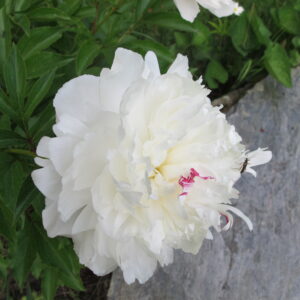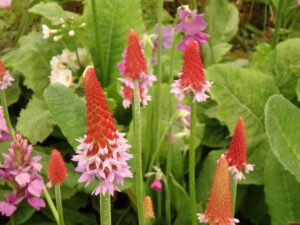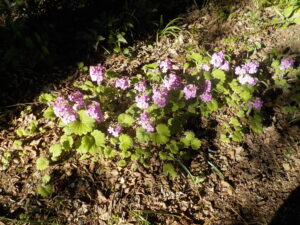Posted on Sunday, May 28, 2023 · Leave a Comment
I’m a sucker for a good looking flower. Back when I was first developing my flower beds I would go to a plant nursery and grab everything and anything that was in bloom and looking great. And I believe in buying multiples: not one plant, but three or five! Needless to say, I was in trouble when I got home and looked for a place to plant them. I needed to create new beds for each truckload of perennials I brought home. Even so, I couldn’t help myself.
Now I am more judicious when I go shopping for plants: I decide ahead of time what I need, and how many. I decide where they will go before I leave home. Still … a few plants seduce me with their beauty every time I arrive at a good greenhouse.
By the way, I’ve heard from many gardeners that some of their perennials, trees and shrubs were damaged by a hard frost in May. Leaves that turned brown will not recover – but will be replaced. I am cutting damaged stems of perennials back to the ground and they should re-sprout. Trees and shrubs that have gone through the winter and leafed out are hardy here, and should send out new leaves on their stems, even if they don’t bloom this year. They have dormant buds that will wake up, and plenty of energy in their roots. I won’t bother taking off the dead leaves. So stop worrying if yours got frost damaged.

Peony ‘Festiva maxima’ that my grandmother grew
Peonies, primroses and barrenwort (which is usually referred to by its scientific name, Epimedium) are blooming in my gardens. I recommend that you buy these now, while in bloom, so you know what you are getting – and if you like them as much as I do.
Some peonies are highly fragrant, others not at all. Some have blossoms with many petals (called doubles) while others have just one or two rings of petals (called singles). Doubles are magnificent but often flop when it rains, sometimes breaking their stems. So you need to tie them to stakes or support them in wire cages made for the task. If you see both kinds in bloom, you can decide what you want to buy.
Most plants have a finite lifespan, but peonies seem to last forever. I have a division of one that was my grandmother’s – and she died in 1953. So plant them well: I dig a wide hole and add compost to it, along with some organic fertilizer – which is naturally slow release. Full sun is best, but they will do okay with 4 to 6 hours of sunshine.
Peonies can be fussy: don’t cover the little growing points beneath the soil with more than ¾ of an inch of soil, or they probably will not bloom. If yours don’t bloom, remove some soil from around them as they are probably too deeply planted.
Primroses, generally, do well in partial to full shade. Some do well in dry soil, but most like moist, rich soil. Read the plant tag carefully before planting. Sometimes I will try a plant in one place, and if, after a year or two, it is not performing well I move it. Sometimes I move a plant more than once to find the right place for it.

Primula vialii is not commonly sold but is wonderful
Arlene Perkins of Montpelier, VT is an expert grower of primroses. She told me long ago that all primroses like to grow under old apple trees. The partial shade is right for most, and the soil is naturally enriched by dropping leaves and fruit over time. It is under a cluster of old wild apples that I have had my best luck with primroses, particularly the candelabra or Japanese primrose (Primula japonica). They have multiplied by seed and root from a few planted 20 years ago to over 500 plants, I estimate.
Last year I planted many Primula viallii (no common name) in the perfect growing conditions for them. They bloomed magnificently last summer but so far not one has shown up again. The blossoms are very different from any I know: like little red-topped elf caps over pink/purple bases. It said to self-sow, and it is early yet, so I might see some yet.
Lastly, I love barrenwort or Epimedium. I have about eight different species or varieties of Epimedium, and all are wonderful. Epimedium grow in light to deep shade and do fine under deciduous trees, despite the competition from tree roots for moisture and minerals. My resource books tell me they do best in moist soils, but I grow them routinely in fairly dry soils. I think rich soil is the key, not the amount of moisture.
The common red one (Epimedium rubrum) blooms early in spring but hides its flowers under its leaves, which I don’t like. But it forms such a dense shade cover with its handsome leaves that no weeds will grow under it – so I forgive it.

This newly planted Epimedium ‘Pretty in Pink’ will develop into a 2-ft wide plant
The colors I grow range from pure purple to red to pink to white, with others a variety of yellows. Again, I suggest buying them in bloom – now – so you can see if the blossoms are prominent above the leaves, or hidden below. The common red one (Epimedium rubrum) blooms early in spring but hides its flowers under its leaves, which I don’t like. But it forms such a dense shade cover with its handsome leaves that no weeds will grow under it – so I forgive it.
I like “collecting” different varieties of plants I like and seeing the differences between different kinds. If one kind does well, its cousins probably will, too. So go buy more of your favorites!
Many thanks to all you readers who have donated to support
Notes from the
Garden. If you have been enjoying the column, learning from it and wish to donate, please go to my website,
www.Gardening-Guy.com and go to store/donations and follow the prompts. Or do it the old fashioned way, and mail a check to Henry Homeyer, PO Box 364, Cornish Flat, NH 03746.





